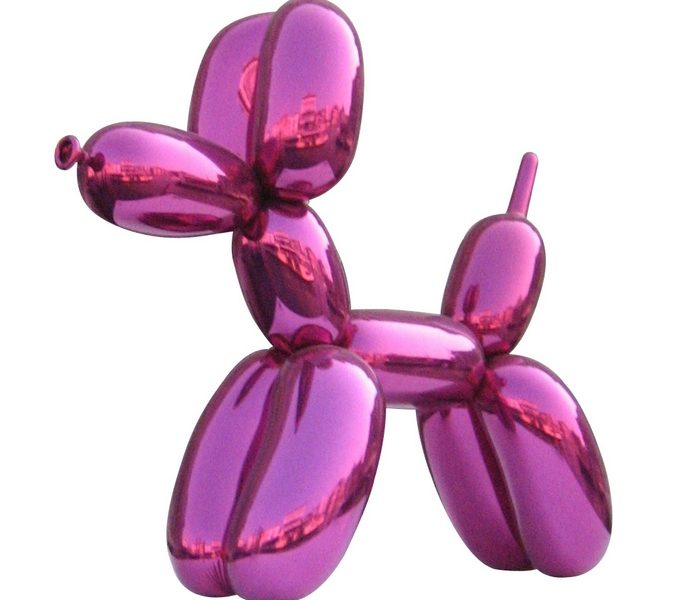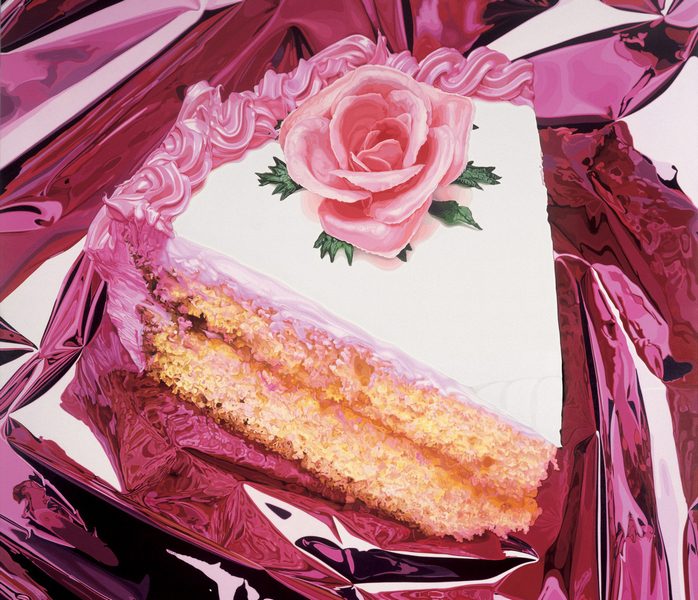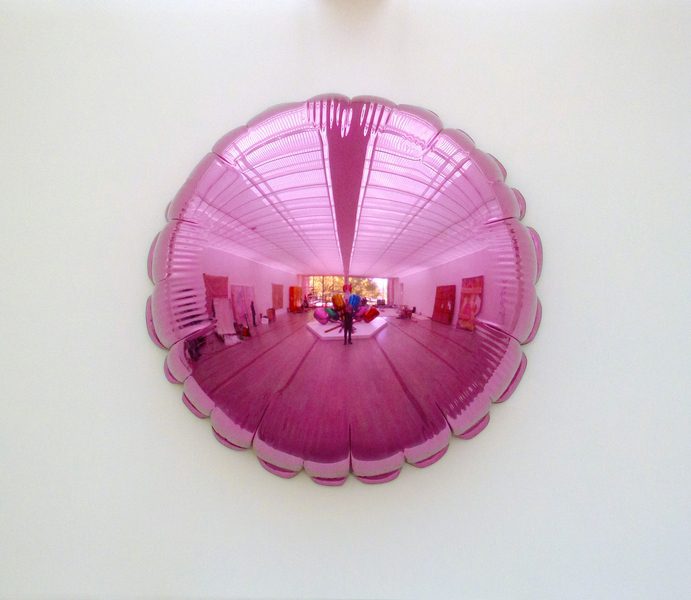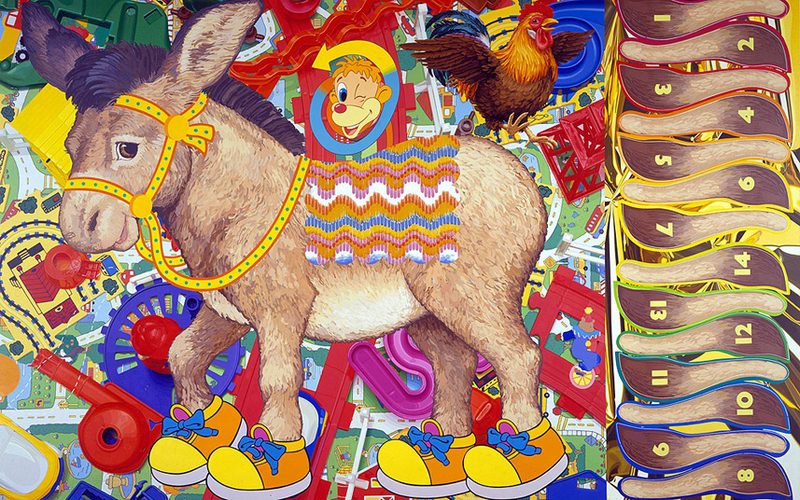INTERVIEW: Jeff Koons
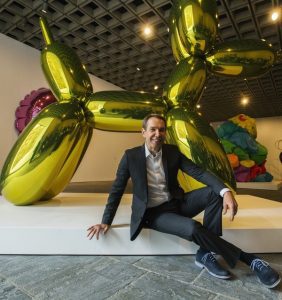 The first artwork from the Dakis Joannou Collection that I saw, at the School of Fine Arts 1996 (a few days before the exhibition “Everything that’s interesting is New”), was the “Michael Jackson & Bubbles”. Is an artwork that causes terrible depression if you observe it very closely, as it is large, from porcelain painted with gold color. Once I faced, I felt such anxiety about contemporary life and culture, through the similarity and identity of the human gaze to that monkey, because I realized the lies and vanity that pervades life, or at least possessed it in previous years, since art is the mirror of life. On the occasion of the retrospective exhibition, organized by the Whitney Museum in New York in Summer, honoring his 35 years course in art, which this period moved to Paris at the Centre Pompidou and will then travel to the Guggenheim Museum Bilbao, we reprint the discussion, we did in 1999-2000, in the exhibition of Deste Foundation “A Millennium Celebration”, with one of the most popular artists of the international art scene, who is both familiar and affable as is his work.
The first artwork from the Dakis Joannou Collection that I saw, at the School of Fine Arts 1996 (a few days before the exhibition “Everything that’s interesting is New”), was the “Michael Jackson & Bubbles”. Is an artwork that causes terrible depression if you observe it very closely, as it is large, from porcelain painted with gold color. Once I faced, I felt such anxiety about contemporary life and culture, through the similarity and identity of the human gaze to that monkey, because I realized the lies and vanity that pervades life, or at least possessed it in previous years, since art is the mirror of life. On the occasion of the retrospective exhibition, organized by the Whitney Museum in New York in Summer, honoring his 35 years course in art, which this period moved to Paris at the Centre Pompidou and will then travel to the Guggenheim Museum Bilbao, we reprint the discussion, we did in 1999-2000, in the exhibition of Deste Foundation “A Millennium Celebration”, with one of the most popular artists of the international art scene, who is both familiar and affable as is his work.
By Efi Michalarou
Ploto: Whitney Museum and Jeff Koons Archive
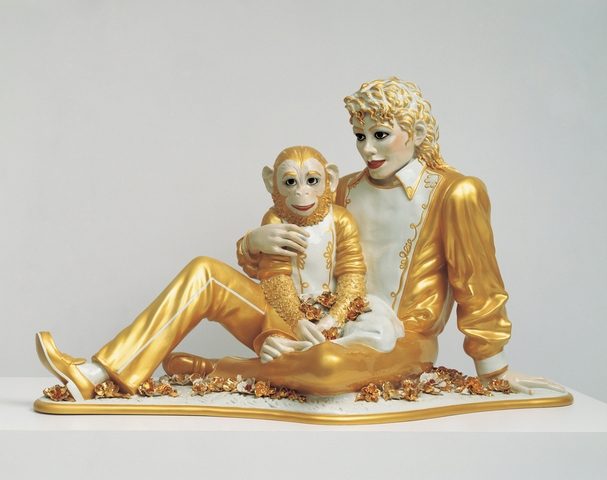
Could you tell us the history of this work?
‘’Michael Jackson & Bubbles’’ was made in 1988 as part of the series ”Banality”. In this series I used fragmented images, trivial and everyday things, like the picture of someone with a lot of puppies in his arms, which referred to a kind of Garden of Eden. The Michael Jackson appears here as a kind of Messiah, referring to the way in which the world faces today celebrities.
“One ball total equilibrium tank” was the first artwork that Dakis Joannou bought from you in 1985. What does this work then and what now means?
I wanted the viewer to see the “One ball total equilibrium tank”, as an absolute, perfect form of existence. The basketballs are at rest and inactivity. There is also a biological connotation: One can see the basketball as a fetus in the uterus. Therefore, I wanted to create a steady equilibrium. However, this was impossible in the context of Physics and the limited space of the aquarium. The works can remain in equilibrium only for five-six-months, after the ball is sitting on the bottom and need maintenance. Ι Decided, therefore, to do the artworks very simple and put the ball to float in water, to enhance the impression of the uterus and the absolute purity.
What means for you this retrospective at the DESTE Foundation and in fact now, at the end of the century?
It is true honor for me to have such a friend and collector, as Dakis Joannou, who has supported my work incredibly over the years. He is a great man dedicated to art and its dissemination. This exhibition is a great honor at this moment. It is an opportunity at the end of the century to show the works I have done over the last 20 years.
How started your relationship with the Dakis Joannou, which developed into a close friendship? Does something like that happen with other collectors too?
As an artist, I have developed friendships with collectors and other people in the world of art. However, my relationship with the Dakis is special. I met him in 1985 when he visited my exhibition in the East Village of New York, and immediately told me: “you have to visit Greece Jeff”. He invited me, I came and we had a wonderful time. His generous friendship was important to me, I love Greece, with the light and the color, it became one of my favorite places.
Making a personal review through your twenty-year course, how things have changed? What has remain the same?
I believe that my desire to produce work has remained the same since I was four or five years old! I really enjoy creating art. Art helps me to identify and broaden my limits. To enrich my life and interests. What may change, as I won some recognition, is that I learned how important it is to practicing a profession that has the potential to influence culturally a wider public, while living a life that maintains a form of moral anonymity without having to come out on TV and make silly statements to remain in the limelight.
What has changed in art, passing from the 80s to the 90s?
In the 80s, art was presented as cynical. Instead, I did not feel I belong in this situation, but I was trying to make an honest job. I think that the art of the 90s turned more to the body and the use of video. However, my own interests remained more focused in the area of collage. I like to think that invention of the technique of collage by Picasso at the beginning of the century and how important was this fact for all media including: The Cinema, which is collage of picture and sound, Video or Advertising that combines image and text, so, my interest in collage, remained stable those two decades.
And in Painting with the series “A Millennium Celebration”?
Yes and in painting, but the collage remains in the center…
What it means for you Art?
I believe that art is based on Philosophy. It is a medium of expression about what it means to be alive.
I guess it is not a coincidence that you have never used video.
I think that is because I have not felt confident enough on this medium. Maybe because I do not know exactly what the work of the director. Recently, however, through the ever-deeper understanding of the collage, I feel more confident. In the near future, I will make a kind of video works in partnership with a new company on the Internet, the pop.com.
What role-plays love in your life? Some consider a challenge to make an artist his “love life” artwork ”. Would you do a similar series with a new romance?
My life is directly connected with my work. In the early 90s I made a series of works entitled “Made in Heaven”, which included my former wife as a model. My intention was to work on the tradition of the Baroque, while trying to give people the confidence to cope with various aspects of immortality in biological level and make a work on beauty. Since, however, the true love led to a condition non-positive, I tend to feel somewhat distant from this series of works.
Knowing many of your works, what I see is a common point that joins them together: passion, soul, color and emphasis on perfection. Really, what is the color of passion?
I believe that the color is as a real communication tool in Art and that different colors evoke different emotions. If I had to combine passion with a color, I would say that it is close to the color of lavender.
I feel that you create a parallel world through your work that is same with the real one, but concurrently so different from real life…
Indeed, my works are involving both sides, if someone want to present it in a convincing way, he must be aware and for the other side. Is possible that some of the most optimistic works have occurred when I was going through one of my worst phases. I therefore agree that projects include inside two parallel realities. I try to make works open and accessible, although some may believe that my work has to do with kitsch. In fact, in a sense is contrary to the kitsch, which I believe is a kind of fetishism, which I think it does not apply to my work. I hope my vocabulary to refer to high issues of contemporary art.
You live and work in New York. What role plays in your work and life the experience of this city?
N. York is an amazing environment. Not apolitical capital, but is economic and cultural capital. Bursting with ideas and is a restless environment in which I feel very comfortable. Besides, mine main interest in life is always the evolution of my work.
We are at the end of an era and the beginning of another. What is your opinion about the future of art?
I think that art will be affected more by technology and will condense inside her more information, while collage will be continue to acquire consecutive layers. I believe that artists will return reinforced in areas such as design and activities from which have been moved away. It may also in the future people to practice art, as a way to meet themselves.
© Interview – Efi Michalarou
Info: Centre George Pompidou, Place Georges-Pompidou, Paris, Duration: 26/11/14-27/4/15, Days & Hours: Wed-Mon: 11:00-22:00, www.centrepompidou.fr
